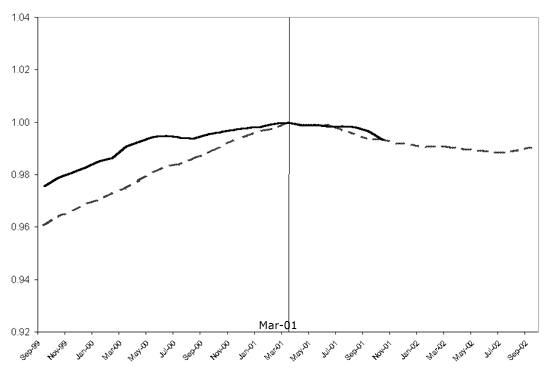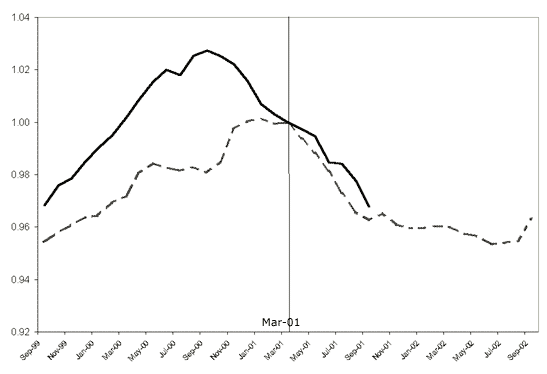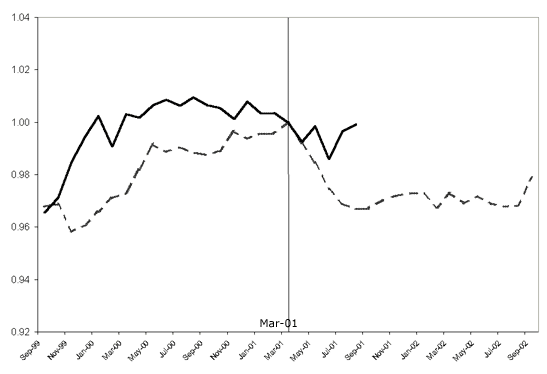Business Cycle Dating Committee Announcement November 26, 2001
Robert Hall, Chair
Martin Feldstein, President, NBER
Ben Bernanke
Jeffrey Frankel
Robert Gordon
Victor Zarnowitz
The NBER's Business Cycle Dating Committee has determined that a peak in business activity occurred in the US economy in March 2001. A peak marks the end of an expansion and the beginning of a recession. The determination of a peak date in March is thus a determination that the expansion that began in March 1991 ended in March 2001 and a recession began. The expansion lasted exactly 10 years, the longest in the NBER's chronology
A recession is a significant decline in activity spread across the economy, lasting more than a few months, visible in industrial production, employment, real income, and wholesale-retail trade. A recession begins just after the economy reaches a peak of activity and ends as the economy reaches its trough. Between trough and peak, the economy is in an expansion. Expansion is the normal state of the economy; most recessions are brief and they have been rare in recent decades.
Because a recession influences the economy broadly and is not confined to one sector, the committee emphasizes economy-wide measures of economic activity. The traditional role of the committee is to maintain a monthly chronology, so the committee refers almost exclusively to monthly indicators. The committee gives relatively little weight to real GDP because it is only measured quarterly and it is subject to continuing, large revisions
The broadest monthly indicator is employment in the entire economy. The committee generally also studies another monthly indicator of economy-wide activity, personal income less transfer payments, in real terms, adjusted for price changes. In addition, the committee refers to two indicators with coverage of manufacturing and goods: (1) the volume of sales of the manufacturing and trade sectors stated in real terms, adjusted for price changes, and (2) industrial production. The Bureau of Economic Analysis of the Commerce Department compiles the first and the Federal Reserve Board the second. Because manufacturing is a relatively small part of the economy, the movements of these indicators often differ from those reflecting other sectors.
Although the four indicators described above are the most important measures considered by the NBER in developing its business cycle chronology, there is no fixed rule about which other measures contribute information to the process.
A recession involves a substantial decline in output and employment. In the past 6 recessions, industrial production fell by an average of 4.6 percent and employment by 1.1 percent. The Bureau waits until the data show whether or not a decline is large enough to qualify as a recession before declaring that a turning point in the economy is a true peak marking the onset of a recession.
Figure 1 shows the recent movements of employment superimposed on the average movement over the past six recessions. Employment reached a peak in March 2001 and declined subsequently. The figure for October is the first to reflect the effects of the attacks of September 11. Through October, the decline in employment has been similar to the average over the first 7 months of recessions. The cumulative decline is now about 0.7 percent, about two-thirds of the total decline in the average recession.
Figure 2 shows industrial production. A peak occurred in September 2000 and the index declined over the next 12 months by close to 6 percent, surpassing the average decline in the earlier recessions of 4.6 percent. Figure 3 shows real manufacturing and trade sales. This measure reached a peak almost a year ago. Figure 4 shows the movements of real personal income less transfers. This measure has continued to rise in recent months and has not yet reached a peak.
The dark line shows the movement of employment in 1999-2001
and the dashed line the average over the past 6 recessions
The dark line shows the movement of industrial production in 1999-2001
and the dashed line the average over the past 6 recessions.
The dark line shows the movement of manufacturing and trade in 1999-2001
and the dashed line the average over the past 6 recessions.
Source: The Conference Board
The dark line shows the movement of income in 1999-2001
and the dashed line the average over the past 6 recessions.
Source: The Conference Board
The data continue to show substantial declines in real activity in manufacturing, the sector reflected in the industrial production index, and in real manufacturing and trade sales. Aggregate employment has fallen substantially as well. Among the four indicators, only income has behaved differently over the past 7 months from recession averages.
The committee is satisfied that the total contraction in the economy is sufficient to merit the determination that a recession is underway. The committee makes this determination by asking itself hypothetically what decision it would make if a turnaround in the economy started just after the most recently observed data. If despite such a turnaround, the episode would qualify as a recession, the committee moves ahead to the second step, the determination of the date of the peak. Prior to the arrival of the data for October 2001, the committee was not sure that the contraction met the criterion. With a cumulative decline in employment approaching one percent and the very large decline in industrial production, the committee has concluded that the criterion has been met now.
The determination of the date of the peak in economic activity was as challenging as usual. In every episode, the major indicators peak in different months. The following table shows the number of months earlier (minus sign) or later (plus sign) that the peak of the indicator occurred relative to the NBER's business-cycle peak date.
| Peak | Industrial Production |
Employment | Real Sales | Real Income |
| 1960 | -3 | 0 | -3 | +1 |
| 1969 | -2 | +3 | -2 | +8 |
| 1973 | 0 | +11 | 0 | 0 |
| 1980 | -7 | +2 | -10 | -1 |
| 1981 | 0 | 0 | -6 | +1 |
| 1990 | +2 | -1 | +1 | 0 |
| 2001 | -6 | 0 | -7 | No peak |
Though manufacturing often leads other sectors, the lead in the current turning point was a little larger than normal. Industrial production peaked in October 2000. For 5 months, until March, the economy outside of manufacturing was expanding faster than manufacturing was shrinking, so that total employment continued to grow. Though the committee considered earlier dates to reflect the divergent paths of manufacturing and the rest of the economy, we determined that the peak should track the behavior of the overall economy.
The committee also determined that the continued growth of real personal income after March 2001 was consistent with the finding of that date as the peak in economic activity. Real income is not precisely a measure of activity-rather, it measures the command of households over resources. During the relevant period, continuing fast growth in productivity and sharp declines in the prices of imports especially oil raised purchasing power while employment was falling.
The committee also maintains a quarterly chronology of the US business cycle. The committee determined that the first quarter of 2001 was a quarterly peak in economic activity. Currently, the National Income and Product Accounts show slight growth of real GDP in the second quarter over the first. The committee did not believe that this evidence merited identifying a peak quarter that did not contain the peak month.
For more information, see the FAQs at the end of this memo.
FAQs
Q: The NBER has dated the beginning of the recession in March 2001. Does this mean that the attacks of September 11 did not have a role in causing the recession?
A. No. Before the attacks, it is possible that the decline in the economy would have been too mild to qualify as a recession. The attacks clearly deepened the contraction and may have been an important factor in turning the episode into a recession.
Q: The financial press often states the definition of a recession as two consecutive quarters of decline in real GDP. How does that relate to the NBER’s recession dating procedure?
A: Most of the recessions identified by our procedures do consist of two or more quarters of declining real GDP, but not all of them. But our procedure differs in a number of ways. First, we use monthly indicators to arrive at a monthly chronology. Second, we use indicators subject to much less frequent revision. Third, we consider the depth of the decline in economic activity. Recall that our definition includes the phrase, “a significant decline in activity.”
Q: Isn’t a recession a period of diminished economic activity?
A: It’s more accurate to say that a recession—the way we use the word—is a period of diminishing activity rather than diminished activity. We identify a month when the economy reached a peak of activity and a later month when the economy reached a trough. The time in between is a recession, a period when the economy is contracting. The following period is an expansion. Economic activity is below normal or diminished for some part of the recession and for some part of the following expansion as well. Some call the period of diminished activity a slump.
Q: You emphasize the payroll survey as a source for data on economy-wide employment. What about the household survey, which showed a decline in employment in August?
A: Although the household survey is a large, well-designed probability sample of the US population, its estimates of total employment appear to be noisier than those from the payroll survey. The downward jump in August, which differs from the payroll data, may be such a random movement. Data in the coming months will help resolve the discrepancy between the two sources of data on employment.
Q: How do the movements of unemployment claims inform the Bureau’s thinking?
A: A bulge in jobless claims would appear to forecast declining employment, but we don't use forecasts and the claims numbers have a lot of noise.
Q: What about the unemployment rate, which jumped 0.4 percentage points in August?
A: Unemployment is generally a lagging indicator. Its modest rise from a very low level to date is consistent with the employment data. The household survey—the source of the unemployment rate data—contains random noise that occasionally results in larger than expected changes, as in August.
Q: How do structural changes in the economy in the 1990s affect the NBER's method for dating business cycles? The Bureau notes that industrial production measures a declining part of the economy. What other substitutes for output bear watching, particularly with regard to service sector activity?
A: Economy-wide employment and real personal income are the most important monthly indicators. At a quarterly frequency, real GDP is informative. Another interesting monthly indicator is aggregate hours of work. For the service sector, the BEA publishes monthly data on consumption of services. Interestingly, these data show that consumption of services has grown more slowly in past months than consumption of durable and non-durable goods.
Q: Regarding movements of income as an indicator of recessions, isn’t it true that real income has not fallen substantially during five of the past nine recessions.
A: That is why employment is probably the single most reliable indicator.






